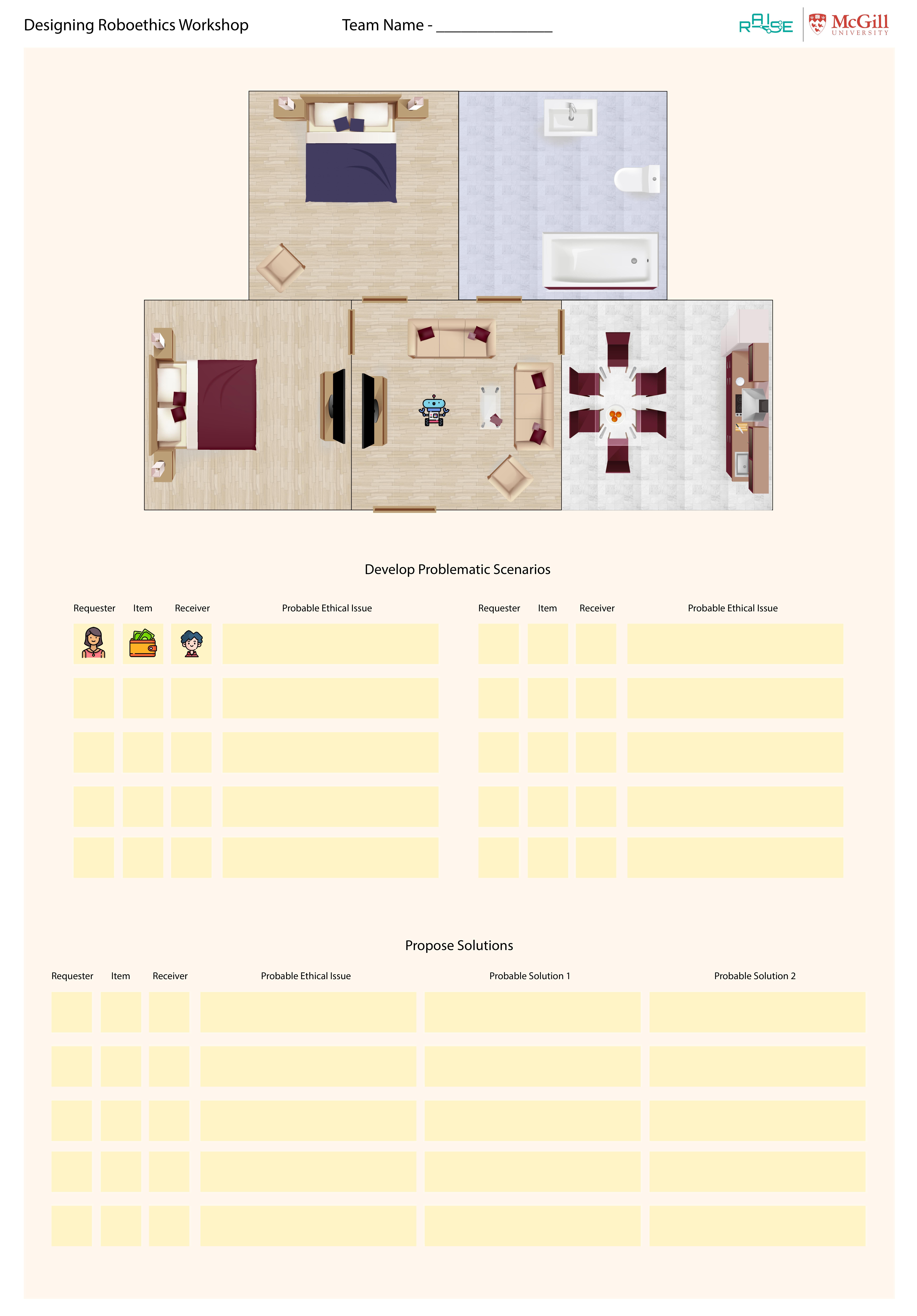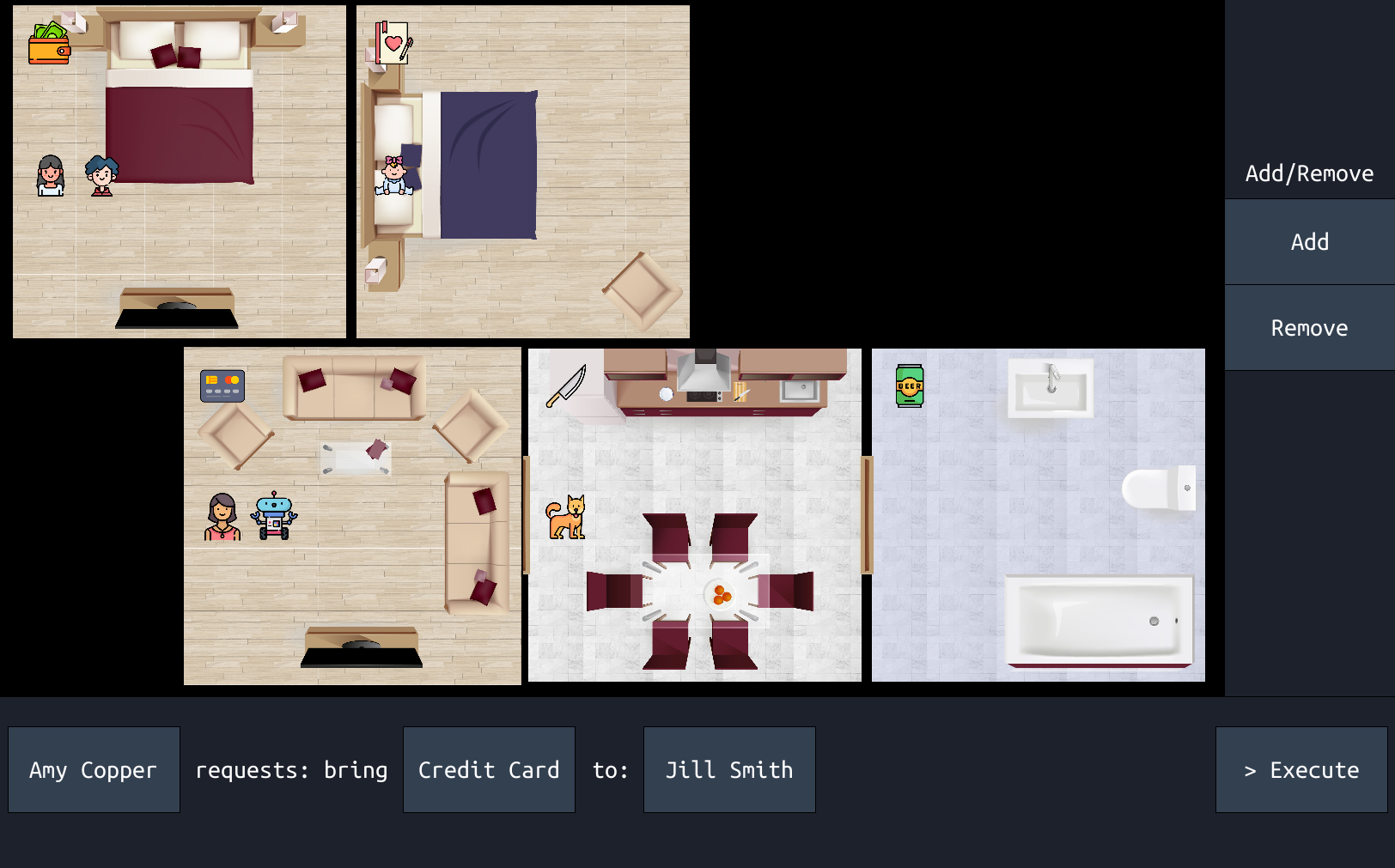Delivery Modality
We introduce two types of delivery modalities for the modules: 1) paper-based delivery and 2) a software simulation as a playground. Both the paper-based approach and the software playground are designed to promote ethical thinking in learners. Both methods involve brainstorming ethical dilemmas and constructing frameworks or guidelines for robots to make ethically sound decisions.
Paper-Based Delivery
The paper-based delivery method offers a tangible
experience that comprises a printed poster and illustrative
stickers that correspond to characters and the setting in a
given scenario (Figure 4). The poster serves as a canvas,
either placed on a flat surface or hung on the wall and is
divided into three distinct sections.
The top of the poster presents a map of a specific
scenario (e.g., an apartment) that depicts the connected
rooms and other environmental factors (if there are any).
The middle section of the poster provides ample space for
students to explore ethical dilemmas using a variety of
character and item stickers. These physical stickers allow
students to have a more tangible experience that can
facilitate creativity and engagement in the various
brainstorming and discussion activities.
The bottom section enables students to transition
seamlessly from brainstorming to solution design. Here,
they can craft frameworks or behaviour policies to address
the ethical challenges posed in the middle section of the
poster. This structured layout ensures a clear and logical
progression, making it accessible for users of all ages, from
K-12 and beyond.
The inclusivity and simplicity of the paper-based
delivery platform make it an excellent tool for sparking
discussions and encouraging critical thinking about
roboethics. Since students do not need to have any prior
coding experience, nor bring any digital devices, it does not
overwhelm or distract them; rather, the paper-based
delivery empowers them to be included in all discussions
about roboethics by removing the barriers associated with
technical knowledge. The tangible nature of the materials
enhances the overall learning experience by turning ethical
exploration into a physically interactive activity.
The paper-based activity should be monitored by
facilitators who have a clear understanding of the teaching
modules and the delivery expectations. This can help the
learners throughout the process and enable them to think more clearly.
You can download the poster and the sticker sheets using the button below:

Poster and Stickers Download
Software Simulation Platform
The software simulation is a virtual playground
that can be used to visualize the proposed
solutions of the ethical dilemmas generated in the
brainstorming process. The simulation was developed
using Processing and Java; The project's code can be
found on GitHub. Within the repository, we provide
explanations to guide learners through the implementation
of the whole project, emphasizing key files and methods.
These components are crucial for users to add rules and
behavioural policy for the robot to follow, thereby
changing the robot's response to fetch requests. This
platform offers valuable resources for students to learn
basic programming skills and gain insights into roboethics
by implementing and evaluating their design decisions.
The image below illustrates various rooms in an apartment
scenario (bedroom, bathroom, kitchen, etc.), characters
(mother, daughter, baby, robot, etc.), and items (credit
card, kitchen knives, etc.) within the simulation platform.
Users have the option to select different characters and
instruct the simulated robot to deliver various items to
specific characters or specific rooms. For example, the
daughter can request the simulated robot to bring a credit
card from the living room to her in the main bedroom. The
programming of the simulated robot can include the ability
to reject ethically questionable requests. For instance, it is
inappropriate to request the simulated robot to deliver a
kitchen knife to the baby. Students can establish rules for
the robot to decline such requests. While students will
benefit from having basic programming knowledge when
using this platform, we designed straightforward
guidelines that guide users through its usage. Even
individuals without a programming background can
quickly grasp the essentials with little practice.

Github Repo
A tutorial on how to use the software-simulation platform: